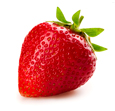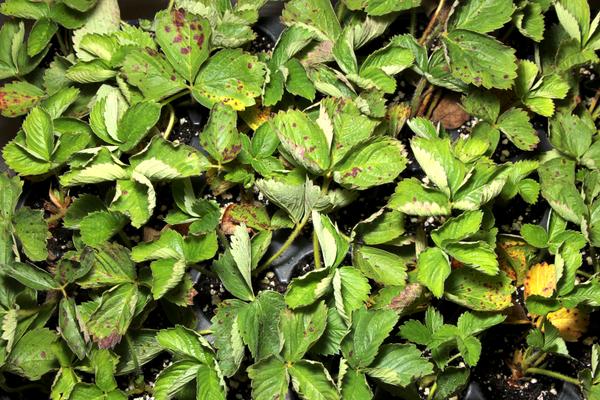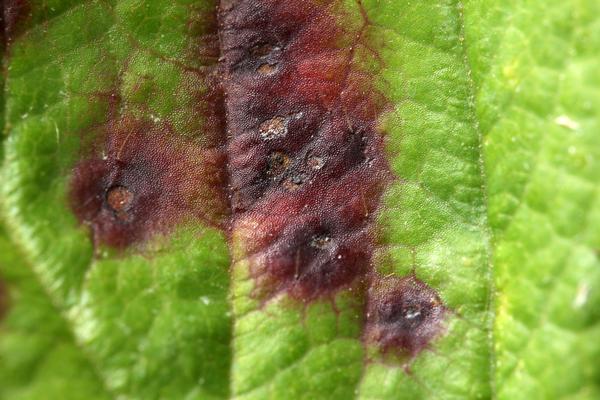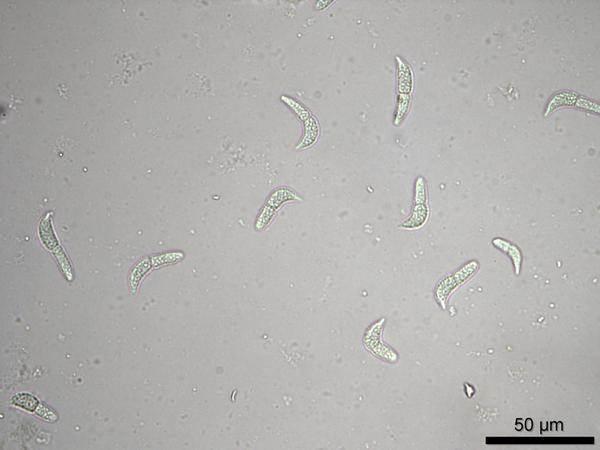Leaf Scorch
- Scientific Name(s)
- Diplocarpon earlianum [Ana: Marssonina fragariae]
- Type
- Disease
- Leaf Color
- Blackish/Purple, Brown or red rust spots, Stipled
- Leaf Location
- Upper surface, Young, Mature
- Petioles Condition
- Lesion
- Petioles Color
- Red
- Field Distribution
- Random
- Prior Environmental
- Rain, Temp. between 20° and 32°
- Season
- Post transplant
Introduction
Leaf Scorch is the most common leaf disease in matted row systems in North Carolina but rarely occurs in annual production systems. The pathogen can survive and cause disease at a wide range of temperatures, and has been reported to cause disease year-round on perennial crops. Replanting frequently is recommended in these systems since the disease usually is not severe the first or second year after planting. Because of this, leaf scorch is not a major problem in annual systems.
Symptoms and Signs
Leaf scorch symptoms are very similar to the early stages of common (Mycosphaerella) leaf spot, with irregular dark purple spots being scattered over the upper leaf surface. As the spots enlarge, they begin to look like drops of tar, and are actually the accumulations of black fruiting bodies (acervuli) of the fungus. The centers of the spots remain purple (in Mycosphaerella leaf spot they are white) and there is no well-defined lesion border. In heavy infections, these regions coalesce and the tissue between the lesions often takes on a purplish to bright red color that is dependent on cultivar, temperature, or other factors. The leaves eventually turn brown, dry up, and curl at the margins giving the leaf a scorched appearance. Examination of the acervuli and conidial morphology can help to distinguish between leaf spot and leaf scorch at this advanced stage of disease. On the upper leaf surfaces of leaf scorch lesions, the acervuli are dark with glistening spore masses and dark apothecia. Petiole lesions are elongate, sunken, with a purplish to brown color and can kill the leaf by girdling the petiole. Runners, fruit stalks, fruit and caps can also become infected. Plants may become weakened and the number and vigor of crowns reduced. Infection predisposes the plants to winter and drought stress. In severe infestations, flowers and fruit may die. Overall, there can be a serious reduction in yield in matted row systems. It has not been observed as a yield-reducing problem in annual production systems.
Disease Cycle
In annual production systems, the disease can come on transplants or tips and build up in the plug production phase in the early fall in the field. However, the pathogen does not cause damage the following spring. In the matted row system, the population can build up to damaging levels. Spores are produced in the spring and midsummer on lower leaf surfaces of dead leaves infected in the previous year, and are spread by wind and splashing rain. Disease increase is favored by leaf wetness during warm weather (68-86°F), and is likely to become more significant on older plantings of susceptible varieties. One ascospore generation (the starting sproes) and several overlapping generations of conidia (spores) are produced every year. Apothecia, a small mushroom-like structure, generally form on infected leaves in the fall and forcibly discharge ascospores, which are wind dispersed, in the springtime. Acervuli are found throughout the season in lesions or on residue of the foliage. Under dry conditions the acervuli can go into dormancy, but once moist conditions return, they again become active and exude conidia in a sticky mass. The conidia are disseminated to new infection sites where they directly penetrate and grow intercellularly.
Management
In matted row or perennial strawberry systems, select a planting site with good air drainage and sun exposure. Cultivars resistant to leaf scorch may be available and need to be evaluated for specific horticultural characteristics. Plant new transplants frequently, and allow adequate spacing between them to increase airflow. Control weeds. Avoid amendment with supplemental nitrogen in spring, as this may enhance disease. Keep moisture levels down and avoid long wetness periods by monitoring irrigation schedules; if possible, use drip irrigation rather than overhead. Remove foliage and crop residues after picking or at renovation to remove inoculum and delay disease increase in late summer and fall. Fungicide treatments are effective during the flowering period, and during late summer and fall.
In annual plasticulture production systems, the disease has not been observed to cause economic damage in fruiting fields and generally does not require action. Although symptoms may be on plants at the time of planting or soon after, the levels of disease are typically low and do not persist into the spring. In plug production facilities, high disease levels may affect the look of the plants and this decreased aesthetic value may impact sales. See our Strawberry IPM Guide at for current recommendations.
Pathogen
Leaf Scorch (Diplocarpon earlianum (Ellis and Everh.) F. A. Wolf teleomorph; Marssonina fragariae (Lib.) Kleb.)
Diplocarpon earlianum is a fungus that causes leaf scorch, one of the most common leaf diseases of strawberry. This ascomycete produces disk-shaped, dark brown to black apothecia (0.25-1 mm) on advanced-stage lesions on strawberry leaves and leaf residues (Heidenreich and Turechek). Mature apothecia contain asci interspersed with unbranched capitate paraphyses. Asci (55-90 x 15-20 µm) are oblong-cylindrical, short-stalked, and contain 8 spores each. Ascospores (18-28 x 4-6 µm) are hyaline, two-celled, and slightly constricted at the septum (Sutton, 1998).
The anamorph of D. earlianum, Marssonina fragariae, produces conidia in dark brown to black acervuli (100-200 µm) on infected leaves (Figure P-1). The conidia (18-30 x 5-7 µm) are hyaline, two-celled, and constricted at the septum (Figure P-2). The distal cell of the conidium is often larger and curved (Sutton, 1998). The host range of D. earlianum and it's anamorpic stage is limited to species and cultivars of Fragaria.
Diagnostic Procedures
Symptoms of leaf scorch may be confused with those of powdery mildew caused by Podosphaera aphanis. As with leaf scorch, powdery mildew infection causes the upward curling of the strawberry leaf edges and the development of purple spots on leaves that are variable in size, from specks to larger spots. D. earlianum can be distinguished from P. aphanis by the presence of black acervuli with glistening spore masses and the absence of mycelium growing on the abaxial leaf surface.
Symptoms of leaf scorch caused by D. earlianum are indistinguishable from those caused by another fungus, Marssonina canadensis. Conidia of M. canadensis measure 31-44 x 5-8 µm (Sutton, 1998).
If fruiting structures of the pathogen are not present on affected plants, individual leaves or leaflets may be incubated in a moist chamber for 24-48 hours to induce sporulation.
References
Heidenreich, C., and Turechek, B. Strawberry Leaf Scorch. Cornell University Extension.
Sutton, J. C. 1998. Leaf Scorch. Pp. 19-20 in: Compendium of Strawberry Diseases, 2nd edition, Maas, J. L. (ed.). APS Press. St. Paul, MN.








